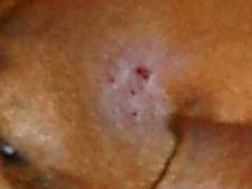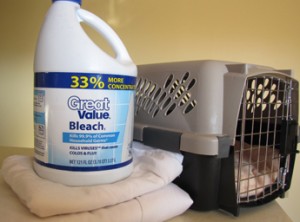=/
Ringworm in Dogs
Athena’s Ordeal
My dog, Athena, is a beautiful red miniature pinscher. She is spirited, lively, and an avid hunter. She hunts everything that moves, and has even caught a squirrel or two. In addition she, like all dogs, likes to roll in dead things. This is how I believe she contracted ringworm. She contracted a species of ringworm, Trichophyton mentagrophytes, which is common rodents. Since the first spot of infection was on her shoulder, I think she rolled on a “wonderful” smelling dead mouse.
Until Athena, got ringworm, I thought ringworm was a simple skin infection that would yield easily to treatment. In her case, however, I was mistaken. In this post, I hope to provide useful information about ringworm causes, signs, symptoms, treatments, and home care that can speed the treatment for other dogs with ringworm. I learned this through researching Athena’s ordeal as well as numerous vet visits, veterinary specialists, tests and cultures, rigorous home health practices, and numerous and sometimes expensive treatments.
What is Ringworm?
Signs and Symptoms
Ringworm, unlike the name implies, is not a worm. It is actually a fungus. Three species of ringworm commonly infect dogs: Microsporum canis, M. gypseum, and Trichophyton mentagrophytes, but M. canis, which causes about 70% of ringworm infections in dogs, is the most common. (See the Merck Veterinary Manuel section on Dermatophytosis) However, the species causing Athena’s infection was T. mentagrophytes,
Often, ringworm infections occur on the face, ears, paws, and tail (WebMD Ringworm in dogs); however, Athena’s first occurred on her shoulder. It then spread to her face and ears. Since T. mentagrophytes primarily infects rodents, and we don’t have rabbits or other rodents as pets, I think she found a dead mouse and rolled in it, as dogs tend to do.
The fungi that cause ringworm reproduce and are transmitted from place to place and from animal to animal by spores. Spores are microscopic particles that are particularly difficult to inactivate. In addition, when an animal has ringworm, its fur is loaded with spores. This is why such large amounts of bleach and extremely meticulous of home hygiene are necessary to disinfect your home. (See section, below).
Common symptoms of ringworm in dogs include the following:
- patches of missing hair (alopecia),
- broken hairs, and
- gray, scaly patches of skin
- pink or red pustules. (See pic, above.)
Home Hygiene
Treating Ringworm Can be a Big Commitment
The home hygiene practices my veterinarian recommended were extensive.
- All furniture should be covered with sheets.
- Wash the sheets and dog bedding every other day.
- Use four cups* of bleach per load.
- Vacuum and dust every day
*If you use a septic tank, this much bleach could damage the bacteria in your septic system. You may want to check out alternative routes of disinfection.
To save my good sheets, I purchased some from the local thrift store. The schedule of changing and bleaching sheets and dog bedding as well as bathing the dog was grueling, but getting rid of the fungal spores was crucial. If your dog sleeps with you, you should also change and bleach the sheets on your bed and your pajamas every day.
Home Remedies
Try the 1-2-3 Punch
Topical antifungals (e.g., Tinactin, Lamisil, Zeasorb) can be started at the first signs of ringworm. Other home measures include home hygiene (described above), and shampooing with an antifungal shampoo. When I noticed a gray, scaly patch on Athena’s shoulder, I called my veterinarian right away. She told me to put a topical antifungal, Tinactin, on it. While many cases of ringworm will clear up with this treatment, we were not so lucky.
Next Steps for Treating Ringworm
Veterinary Care
Next, our veterinarian prescribed oral antifungal medicine. First, she prescribed ketoconazole, at a low dose, but that didn’t clear up the ringworm. She increased the dose, but that just made Athena sick. Then, she prescribed itraconazole, but that medicine was expensive and didn’t help, either. This was a very resilient ringworm!
In severe outbreaks, like Athena’s was becoming, secondary bacterial infections are a concern. These lesions looked scabby and red–think of a fresh scab from a skinned knee. This is in contrast to the gray or pink scales of the fungal infection. The red, bloody looking scabs, which were the size of a pencil eraser on Athena, were on her neck and surrounding areas.
If your dog experiences hair loss will likely grow back; however, it can take several weeks or months. If the infection is not treated right away or is tenacious, like Athena’s was, the hair loss could be permanent.
How to Prepare for Your Trip to the Doggie Dermatologist
A Veterinary Dermatologist Can be a Great Resource
-
Items to remember…
- Avoid grooming
- Stop antihistamines and steroids*
- Bring your vet’s phone and fax numbers and medical records
- Bring dog food ingredient list
*Check with your vet for instructions
Now, it was time for the doggie dermatologist. A veterinary dermatologist may be able to definitively diagnose the ringworm by finding out what species of fungus is causing the problem. She first cultured the fungus by taking skin scrapings and hair from the affected area. She incubated the samples on a special medium conducive to bacterial growth. Then, she stained the resulting fungi with a special dye and looked at it under a microscope. The culture came back positive for Trichophyton mentagrophytes. This fungus is most common in rodents, but does occasionally cause ringworm in dogs (approx. 10% of ringworm cases in dogs are T. mentagrophytes).
The following is an excerpt from the web page of one veterinary dermatology clinic (Animal Dermatology Referral Clinic). It describes their recommendations for how to prepare for an appointment. Your veterinary dermagologist may have similar instructions:
It is best if you avoid grooming your pet and administering antihistamines and/or steroids before your first visit to our office. Please discuss a safe withdrawal protocol with your pet’s family veterinarian or our office staff. If withdrawal from these medications is not possible due to severe reactions, do not worry, the veterinary dermatologist can discuss options during your first visit.
It is also essential that you bring your vet’s phone and fax number and any medical records that have not been faxed already. In addition, you may want to bring an ingredient list from the label of your dog’s food as allergies can sometimes be a problem in dogs and should be ruled out. A trip to the veterinary dermatologist can be expensive (my visit was about $120), but it can be worth it for the sake of the dog, and potentially your pocket book. If, by visiting a specialist, you are able to find a medicine more specific to your dog’s needs, you may not waste money on other expensive medicines.
Ringworm is Also a Human Pathogen
My Ordeal with Ringworm
Some species of ringworm are not transmissible to humans. However, T. mentagrophytes is, at least in my case. Not long after Athena started showing symptoms of ringworm, I did, too. Anyone who has had a fungal infection like athlete’s foot or ringworm knows how itchy, irritating, tenacious, and even painful a fungal infection can be. My ringworm was all of the above. I went to my family doctor. I tried both oral and topical antifungals in various combinations. Just when I thought the infection was gone, an itchy, scaly patch would crop up again, and I had to start all over.
My family doctor referred me to a dermatologist, who did a biopsy. The diagnosis of ringworm was confirmed, and the mycelia (structures found in fungi) were “consistent with a Trichophyton species.” The dog and I had been transferring the ringworm back and forth. We both had to be fungus-free and get rid of all the spores in the house to ever be rid of this irritating, if not dreadful, infection.
To confound the problem, I was unable to take any of the oral antifungals usually prescribed for ringworm due to medication interactions. The first medicine the dermatrologist recommended was the over the counter topical Lamisil. After 4 weeks, my symptoms resolved, and after 8 weeks, I stopped using the cream. Athena’s infection seemed to be better, too. However, after I quit using the cream, Athena’s and my ringworm both returned.
Next, the dermatologist recommended I use three different topicals: Tinactin, Lamisil, and Zeasorb. When I used these three medicines, my ringworm finally cleared, and I hope never to return. The End. Hopefully…










3 comments
Mick
March 19, 2016 at 5:19 pm (UTC 0) Link to this comment
Thanks because I saw my min pin has a bald spot on shoulder so I googled & came to here. It appearances that this problem can run into several thousands of dollars and hundreds of hours in order to solve it. Your post has enabled me to make an informed decision. This is not something I can afford nor am I equipped to deal with. I will seek to give the min pin away.
Mo Fash
July 23, 2015 at 1:18 pm (UTC 0) Link to this comment
Specifically what treatment helped clear your pup? My 4 year old, ten pound Shih Tzu just returned from boarding with a two-dog family for 18 days and I found what I thought was a scratch on her right rear. Treated with colloidal silver, swelling went down but scabs and bump remained. Took her to vet four days ago – Ringworm! Shaved, and given MicaVed Lotion 1% to apply twice daily (with gloves on). Bedding, toys, etc… washed and bleached. Daily house cleaning non-stop. She has two more big breakouts in the surrounding area. Yesterday, he started her on Professional Formula Mycostat Complex but she is getting sicker everyday. At this point, I think it’s systemic. Vet has been reluctant to put her on pharmaceutical meds because of side effect profile. Need your input, quickly please. Many thanks…
Jana
July 23, 2015 at 7:40 pm (UTC 0) Link to this comment
We did many of the things you described, but what finally worked was a combination of different over the counter topical fungals and a vet-prescribed shampoo regime. We used Tinactin cream, Lamisil cream, and Zeasorb powder, and bathed her every other day with Ketochlor shampoo. We put one of the creams on in the morning and the other at night. Then, we put the powder over the cream. We used an Elizabethan collar for at least 30 minutes after application of the cream so that she would not lick it off. Keep the washing and cleaning. I know it’s a pain, but it does help. Also, keep in touch with your vet. She can recommend thing specifically to rid your dog of ringworm. Good luck, and hang in there!